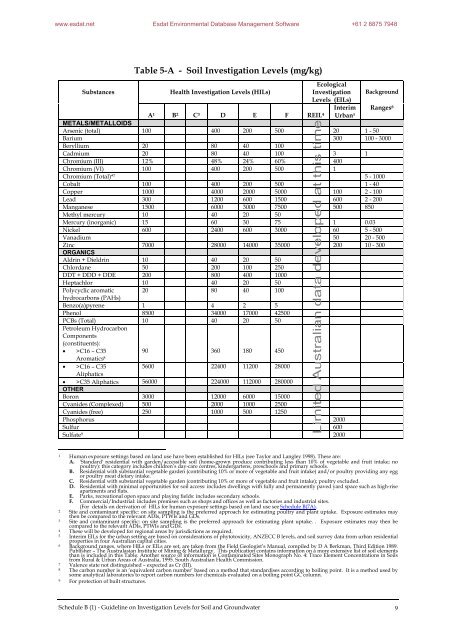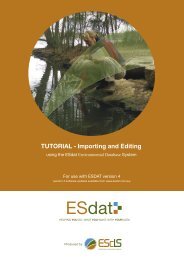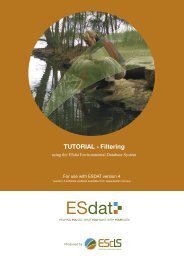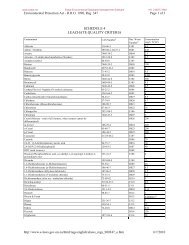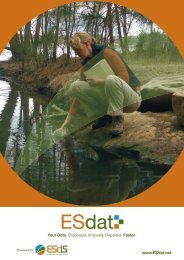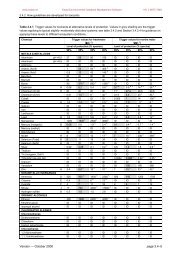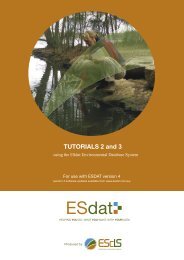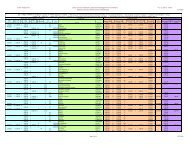Table 5-A - Soil Investigation Levels (mg/kg) - ESdat
Table 5-A - Soil Investigation Levels (mg/kg) - ESdat
Table 5-A - Soil Investigation Levels (mg/kg) - ESdat
Create successful ePaper yourself
Turn your PDF publications into a flip-book with our unique Google optimized e-Paper software.
www.esdat.net Esdat Environmental Database Management Software +61 2 8875 7948<br />
<strong>Table</strong> 5-A - <strong>Soil</strong> <strong>Investigation</strong> <strong>Levels</strong> (<strong>mg</strong>/<strong>kg</strong>)<br />
Substances Health <strong>Investigation</strong> <strong>Levels</strong> (HILs)<br />
Ecological<br />
<strong>Investigation</strong><br />
<strong>Levels</strong> (EILs)<br />
A1 B2 C3 D E F REIL4 Interim<br />
Urban5 Bac<strong>kg</strong>round<br />
Ranges 6<br />
METALS/METALLOIDS<br />
Arsenic (total) 100 400 200 500 20 1 - 50<br />
Barium 300 100 - 3000<br />
Beryllium 20 80 40 100<br />
Cadmium 20 80 40 100 3 1<br />
Chromium (III) 12% 48% 24% 60% 400<br />
Chromium (VI) 100 400 200 500 1<br />
Chromium (Total)* 7 5 - 1000<br />
Cobalt 100 400 200 500 1 - 40<br />
Copper 1000 4000 2000 5000 100 2 - 100<br />
Lead 300 1200 600 1500 600 2 - 200<br />
Manganese 1500 6000 3000 7500 500 850<br />
Methyl mercury 10 40 20 50<br />
Mercury (inorganic) 15 60 30 75 1 0.03<br />
Nickel 600 2400 600 3000 60 5 - 500<br />
Vanadium 50 20 - 500<br />
Zinc 7000 28000 14000 35000 200 10 - 300<br />
ORGANICS<br />
Aldrin + Dieldrin 10 40 20 50<br />
Chlordane 50 200 100 250<br />
DDT + DDD + DDE 200 800 400 1000<br />
Heptachlor 10 40 20 50<br />
Polycyclic aromatic<br />
hydrocarbons (PAHs)<br />
20 80 40 100<br />
Benzo(a)pyrene 1 4 2 5<br />
Phenol 8500 34000 17000 42500<br />
PCBs (Total)<br />
Petroleum Hydrocarbon<br />
Components<br />
(constituents):<br />
10 40 20 50<br />
• >C16 – C35<br />
90 360 180 450<br />
Aromatics 8<br />
• >C16 – C35<br />
Aliphatics<br />
5600 22400 11200 28000<br />
• >C35 Aliphatics 56000 224000 112000 280000<br />
OTHER<br />
Boron 3000 12000 6000 15000<br />
Cyanides (Complexed) 500 2000 1000 2500<br />
Cyanides (free) 250 1000 500 1250<br />
Phosphorus 2000<br />
Sulfur 600<br />
Sulfate9 2000<br />
1 Human exposure settings based on land use have been established for HILs (see Taylor and Langley 1998). These are:<br />
A. 'Standard' residential with garden/accessible soil (home-grown produce contributing less than 10% of vegetable and fruit intake; no<br />
poultry): this category includes children’s day-care centres, kindergartens, preschools and primary schools.<br />
B. Residential with substantial vegetable garden (contributing 10% or more of vegetable and fruit intake) and/or poultry providing any egg<br />
or poultry meat dietary intake.<br />
C. Residential with substantial vegetable garden (contributing 10% or more of vegetable and fruit intake); poultry excluded.<br />
D. Residential with minimal opportunities for soil access: includes dwellings with fully and permanently paved yard space such as high-rise<br />
apartments and flats.<br />
E. Parks, recreational open space and playing fields: includes secondary schools.<br />
F. Commercial/Industrial: includes premises such as shops and offices as well as factories and industrial sites.<br />
(For details on derivation of HILs for human exposure settings based on land use see Schedule B(7A).<br />
2 Site and contaminant specific: on site sampling is the preferred approach for estimating poultry and plant uptake. Exposure estimates may<br />
then be compared to the relevant ADIs, PTWIs and GDs.<br />
3 Site and contaminant specific: on site sampling is the preferred approach for estimating plant uptake. . Exposure estimates may then be<br />
compared to the relevant ADIs, PTWIs and GDs.<br />
4 These will be developed for regional areas by jurisdictions as required.<br />
5 Interim EILs for the urban setting are based on considerations of phytotoxicity, ANZECC B levels, and soil survey data from urban residential<br />
properties in four Australian capital cities.<br />
6 Bac<strong>kg</strong>round ranges, where HILs or EILs are set, are taken from the Field Geologist’s Manual, compiled by D A Berkman, Third Edition 1989.<br />
Publisher – The Australasian Institute of Mining & Metallurgy. This publication contains information on a more extensive list of soil elements<br />
than is included in this <strong>Table</strong>. Another source of information is Contaminated Sites Monograph No. 4: Trace Element Concentrations in <strong>Soil</strong>s<br />
from Rural & Urban Areas of Australia, 1995. South Australian Health Commission.<br />
7 Valence state not distinguished – expected as Cr (III).<br />
8 The carbon number is an ‘equivalent carbon number’ based on a method that standardises according to boiling point. It is a method used by<br />
some analytical laboratories to report carbon numbers for chemicals evaluated on a boiling point GC column.<br />
9 For protection of built structures.<br />
Schedule B (1) - Guideline on <strong>Investigation</strong> <strong>Levels</strong> for <strong>Soil</strong> and Groundwater 9
www.esdat.net Esdat Environmental Database Management Software +61 2 8875 7948<br />
<strong>Table</strong> 5-B<br />
Groundwater <strong>Investigation</strong> <strong>Levels</strong><br />
SETTING 10 Aquatic Ecosystems 11 Drinking<br />
Water<br />
METALS/METALLOIDS<br />
Marine<br />
Waters<br />
µg/L<br />
Fresh<br />
Waters<br />
Agricultural 9<br />
Schedule B (1) - Guideline on <strong>Investigation</strong> <strong>Levels</strong> for <strong>Soil</strong> and Groundwater 10<br />
µg/L<br />
Aluminium
www.esdat.net Esdat Environmental Database Management Software +61 2 8875 7948<br />
SETTING 10 Aquatic Ecosystems 11 Drinking<br />
Water<br />
ORGANICS (cont..)<br />
Monocyclic aromatic compounds<br />
Marine<br />
Waters<br />
µg/L<br />
Fresh<br />
Waters<br />
Agricultural 9<br />
Schedule B (1) - Guideline on <strong>Investigation</strong> <strong>Levels</strong> for <strong>Soil</strong> and Groundwater 11<br />
µg/L<br />
Health 10/<br />
Aesthetic 11<br />
<strong>mg</strong>/L<br />
Benzene 300.0 300.0 0.001<br />
Chlorinated benzenes 0.007-15.0 12<br />
Chlorinated phenols 0.2-8.0 0.05-18.0 13 0.04-1.5<br />
Phenol 50.0 50.0<br />
Toluene 300.0 0.8 (0.025)<br />
Xylene 0.6 (0.02)<br />
Pesticides Footnote 14 Footnote 15 Footnote 16<br />
Aldrin 10.0 ng/L 10.0 ng/L 0.0003<br />
Chlordane 4.0 ng/L 4.0 ng/L 0.001<br />
DDT 1.0 ng/L 1.0 ng/L 0.02<br />
Dieldrin 2.0 ng/L 2.0 ng/L 0.0003<br />
Heptachlor 10.0 ng/L 10.0 ng/L 0.0003<br />
Phthalate esters<br />
di-n-butylphthalate 4.0<br />
di(2-ethylhexyl)phthalate 0.6<br />
other phthalate esters 0.2<br />
Polyaromatic hydrocarbons<br />
Polychlorinated biphenyls 0.004 0.001<br />
Polycyclic aromatic hydrocarbons 3.0 3.0<br />
Styrene (vinylbenzene) 0.03 (0.004)<br />
Tetrachloroethene 0.05<br />
Trichlorobenzenes (total) 0.03 (0.005)<br />
Vinyl chloride 0.0003<br />
OTHER<br />
Irrigation<br />
(<strong>mg</strong>/L)<br />
Livestock<br />
(<strong>mg</strong>/L)<br />
See<br />
guidelines<br />
for raw<br />
water for<br />
drinking<br />
water<br />
supply<br />
(AWQG,<br />
ANZECC<br />
1992)<br />
Calcium 1,000.0<br />
Chloride (250.0) 30.0<br />
700.0 17<br />
Cyanide 5 0.005 0.08<br />
Fluoride 1.5 1.0 2.0<br />
Nitrate-N 50.0 30.0<br />
Nitrite-N 3.0 10.0<br />
AESTHETIC PARAMETERS<br />
Colour and clarity < 10%<br />
change in<br />
euphotic<br />
depth<br />
< 10%<br />
change in<br />
euphotic<br />
depth<br />
12 See table 2.8, p.2-49 AWQG (ANZECC 1992) for further information<br />
13 see table 2.9, p2-50 AWQG (ANZECC 1992) for further information<br />
14 see table 2.10 also, p.2-55 (ANZECC 1992) for further information<br />
15 see table 2.10 also, p.2-55 (ANZECC 1992) for further information<br />
16 see table on p32 (Guidelines for Pesticides), p32 (NHMRC/ARMCANZ 1996)<br />
17 Maximum chloride concentration should be set according to the sensitivity of the crop. For further information. (See <strong>Table</strong>s 5.1, 5.2, 5.3, 5.4,<br />
ANZECC 1992)


